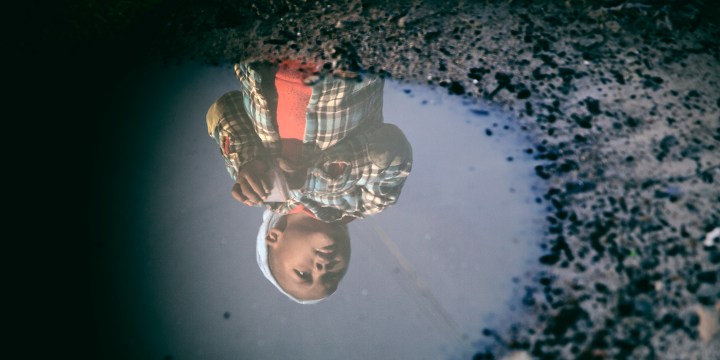South Africa
TB in children: Important research being done in Cape Town

Medicines that taste like strawberries or mangos, cutting-edge trials on preventing TB in kids, measuring how children’s bodies take up TB medicines – this World TB Day feature highlights the work done by the Desmond Tutu TB Centre.
Tuesday 24 March was World TB Day and the World Health Organisation set this year’s theme as “It’s time” — emphasising that it is time to accelerate diagnosis, treatment and prevention of the disease, not to mention time to end tuberculosis.
Ending TB, and specifically ending TB in children, has long been the focus of the Desmond Tutu TB Centre (DTTC), part of Stellenbosch University’s Faculty of Health Sciences.
Spotlight spoke to DTTC director Professor Anneke Hesseling, as well as Dr Megan Palmer, medical director at the centre’s pharmacokinetics (PK) unit, based at Brooklyn Chest Hospital, about some of the groundbreaking work in paediatric TB.
The unit at Brooklyn Chest Hospital
Tucked away in a neighbourhood in Brooklyn, one of Cape Town’s northern suburbs, is Brooklyn Chest Hospital (BCH). A provincial TB hospital that treats both adults and children, it is home to the DTTC’s paediatric BCH PK research unit.
“Here we currently do mostly work around drug-resistant TB and PK,” says Palmer.
“PK stands for ‘pharmacokinetics’ and is basically the study of how a drug moves through a child’s body. So you drink a tablet but your body handles each medicine in a different way.”
To perform PKs, as Palmer calls them, serial blood samples are taken from children over a 24-hour period in order to measure and monitor the drug concentration levels in the blood.
“This helps us to establish what the optimal doses of the treatment are and whether we should dose kids differently according to weight or age or HIV status or nutritional status. A lot of the work that’s been done here has informed the doses of TB drugs that are used to treat MDR-TB in children around the world,” says Palmer.
“The [PK] work we do is largely about ensuring we use drugs that are safe in children, that we use drugs at the correct doses to minimise side effects, to make sure the drugs we use are effective and the children can actually get cured or manage to complete the treatment. And then there is also a lot of work on formulations.”
One in 10 cases are in kids
“TB is a disease of poverty and, statistically, one out of every 10 cases of TB occurs in children. And drug companies are not really interested in the paediatric TB drug market,” reveals Hesseling.
Part of the DTTC’s work is to engage with pharmaceutical companies on how to create child-friendly formulations.
Celebrations were in order last October after UNITAID (a multinational organisation that invests in innovations relating to HIV/AIDS, TB and malaria) gave the DTTC a grant valued at more than R280 million to develop and evaluate child-friendly treatments and preventative therapies for MDR-TB.
The grant will support “Better Evidence and Formulations for Improved MDR-TB Treatment for Children”, the so-called BENEFIT Kids project, which will run until 2022.
“[The study] aims to address research gaps related to high-priority, second-line TB drugs; these are the drugs that are used to treat and prevent MDR-TB. This is a big project that is made up of several smaller studies, trials and projects,” explains Palmer.
The project will be implemented in three countries: India, the Philippines and South Africa.
“Children with drug-resistant TB are a very neglected population and estimates are that about 95% of children [globally] with drug-resistant TB never access treatment; and then treatment we use in children is often just extrapolated from what we use in adults,” says Palmer.
Not small adults
“Children are not small adults, they metabolise differently and the drugs work differently in children so it’s really important to generate data safely from children so we can really inform which treatments are safe to be used.”
Palmer tells Spotlight that originally children with MDR-TB had to be treated for up to 18 months. Most of the time this required hospitalisation and daily, painful injections.
“The injections are painful but they also cause a significant amount of hearing loss as a side effect. Historically, children were admitted here at Brooklyn Chest Hospital for almost the entire duration of their treatment. [They were] separated from families, admitted into hospital for up to 18 months, [had] daily injections; and that’s just not good enough,” she says.
“So, over the years, and with contributions from the studies we’ve implemented here at DTTC and work that’s happened around the world, South Africa has moved away from that so that most children receive shorter MDR-TB treatment regimens without the need for daily injections with their unacceptable side effects. Many children can be treated at home.
“Everything we’re doing now is addressing a major knowledge gap,” says Hesseling.
TB Champ
TB Champ is a clinical trial under the BENEFIT Kids project and looks at preventing MDR-TB in children under the age of five. TB Champ is only testing one drug, the antibiotic levofloxacin.
“Preventing TB is far more effective than treating TB, particularly from a public health perspective, so this is an important trial,” says Palmer.
According to Hesseling, no clinical trial has ever been done on preventing drug-resistant TB in children and, as a result, there is no evidence to guide international and national recommendations.
“Prevention is much more cost-effective than cure,” adds Hesseling. Treating MDR-TB is more complicated than treating DS-TB and includes more medicines and possible hospitalisation, all of which can be avoided if the disease is prevented.
“One of 20 kids in South Africa that gets TB, gets drug-resistant (MDR) TB,” says Hesseling.
Study 35
“Prevention is better than cure”, says Hesseling. “But prevention needs to be feasible.”
In October of last year, the DTTC launched Study 35, a preventative study that looks at using a shorter treatment regimen and a new combination of drugs to prevent drug-sensitive TB in children under the age of 12.
“I think a really important area for prevention currently is looking at shorter ways to prevent drug-susceptible [drug-sensitive] TB in kids and also ways to prevent drug-resistant [MDR/XDR] TB in kids, so that’s an area where we are doing quite a lot of research,” says Hesseling.
“The standard [for preventing drug-sensitive TB] has been to give six months of isoniazid therapy, [but] the uptake is extremely poor and, of the kids that start the regimen, fewer than 20% will go past month two. In essence, it really is not easily implemented.”
Study 35 is about short-course preventative therapy for drug-sensitive TB in children, which, Hesseling says, has already been shown to work well in adults. Instead of six months of daily treatment, Study 35 trials 12 doses of preventative therapy, a once a week medication over the course of three months.
“Getting an antibiotic into a child every day for six months is not fun, so a new regimen, [that’s] been tested, evaluated and done really well in adults and kids is called 3HP,” says Hesseling. This 3HP is a combination of isoniazid and rifapentine and when given as 12 doses over three months has been shown to be safer and just as effective as the six-month daily treatment of isoniazid.
“The idea is that it would really improve the uptake of the prevention regimen so kids could actually take it.”
“What we need to know in general then, [is] how to get this into kids. We need a formulation or a form of the pill that kids can take like a tablet, and we need to know what dose you give to children and how safe it is,” she adds.
Making medicines taste better
As part of the DTTC’s clinical trials, studies and PK work, new drug formulations are being investigated for both the prevention and treatment of MDR-TB.
“A lot of these medicines are adult drugs that are crushed and mixed in yoghurt or water or the children have to chew them and they taste bitter and horrible, so some of the work we do here is to work with pharmaceutical companies to actually look at formulations that are child-friendly and that taste nice,” says Palmer.
The DTTC teams have pushed towards making TB prevention and treatment more child-friendly for years. Their child-sensitive and child-focused staff have worked in partnership with their social science team to improve TB care for children.
DTTC’s social science team has worked in Brooklyn Chest to interview children, caregivers and parents on the type of medicines children like and don’t like to take as well as what the experience of being hospitalised is like and how it could be improved.
“We’re hoping to be able to also contribute evidence about how to make things more child-friendly,” says Palmer.
Based at the BCH research unit, study nurse Adelaide Carelse said new medications DTTC are developing had a much higher approval rate by children and are easily dispersible in water.
“The medication that is on the market now doesn’t taste nice,” said Carelse.
“The children don’t want to drink it [and] get nauseous. The new medication we are developing now tastes like maybe strawberry or mango and [the kids] take that medication better,” says Carelse.
“We might crush it and mix it with water. Most of the trials we’re doing now we have to mix it with a certain amount of water, versus the old drugs we used, which we had to crush and mix with maybe yoghurt or juice to give it a better taste,” adds Carelse.
Inside the ward
Study nurse Ragmat Saul gave Spotlight a tour of the research unit’s patient ward.
Before entering the ward, Spotlight’s journalist was given a mask. According to Saul, the research unit has not yet suffered a shortage of masks in light of the Covid-19 pandemic.
The ward is small with five patient beds and one separate isolation bed. Children’s cartoon characters adorn the light yellow walls of the ward, and a patient and family were quietly playing in the ward’s adjoining family room.
“I love working here because I can see when they’re giving the patients the medication; it really helps the kids,” says Saul.
“We also test their blood and you can see there are results, the patients are getting better and we can move forward. I think that if they do go on with [the research work], TB won’t exist in a few years’ time.”
“[The families] are always happy with the treatment here, they will always say that they’re happy with the study we are doing,” says Saul.
Saul adds that children seemed to be responding well to the new child-friendly formulations, “giving it a thumbs up”.
Hope for the future
“We’ve probably in the last 10 years made more progress than in the last 50 years with regards to TB therapeutics,” says Palmer.
“We do have some new drugs to treat drug-resistant TB; bedaquiline, delamanid, which are both highly efficacious. So if you have drugs that are stronger, then you might be able to kill the organism quicker and treat for shorter periods. These new drugs which have also been trialled here, are one of the reasons that treatment regimens in adults and children have been shortened.”
“I would say we are finally gaining ground in TB, but it’s taken a very long time and it’s been a disease that’s been largely neglected.” DM
This article was produced by Spotlight – health journalism in the public interest.





















 Become an Insider
Become an Insider